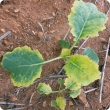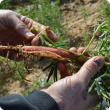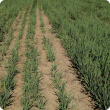Crops
The Department of Primary Industries and Regional Development continues to support the growth and international competitiveness of all crop industries in Western Australia.
With a 2400 kilometre span from its tropical north to its temperate south, WA supports a broad range of cropping industries from rain-fed winter cereals through to irrigated horticultural crops.
In the 2012/13 year the WA cropping industries exported a total of $3.9 billion which comprised: $3.1 billion of cereals, $859 million of pulses, pastures and oilseeds, $142 million of horticultural crops. The major contributors to these exports were wheat ($2.7 billion), canola ($756 million), barley ($377 million), lupins ($42 million), carrots at $48 million, oats ($12 million), and strawberries at $5.5 million.
Filter by search
Filter by topic
- (-) Remove Grains filter Grains
- (-) Remove Production & postharvest filter Production & postharvest
- Plant nutrition (75) Apply Plant nutrition filter
- Grains research & development (70) Apply Grains research & development filter
- Canola (54) Apply Canola filter
- Sowing (47) Apply Sowing filter
- Wheat (39) Apply Wheat filter
- Climate, land & water (25) Apply Climate, land & water filter
- Fertiliser (23) Apply Fertiliser filter
- Breeding & varieties (22) Apply Breeding & varieties filter
- Soil management (22) Apply Soil management filter
- Barley (21) Apply Barley filter
- Soils (20) Apply Soils filter
- Harvesting (17) Apply Harvesting filter
- Soil acidity (16) Apply Soil acidity filter
- Pulses (16) Apply Pulses filter
- Oats (15) Apply Oats filter
- Lupins (14) Apply Lupins filter
- Managing soils (12) Apply Managing soils filter
- Liming (11) Apply Liming filter
- Field peas (11) Apply Field peas filter
- Pests, weeds & diseases (9) Apply Pests, weeds & diseases filter
- Hay production (8) Apply Hay production filter
- Postharvest (8) Apply Postharvest filter
- Soil constraints (6) Apply Soil constraints filter
- Climate & weather (6) Apply Climate & weather filter
- Food, export & investment (5) Apply Food, export & investment filter
- Pastures (5) Apply Pastures filter
- Storage (4) Apply Storage filter
- Grains Research & Development (4) Apply Grains Research & Development filter
- Chickpeas (4) Apply Chickpeas filter
- Diseases (4) Apply Diseases filter
- Frost (3) Apply Frost filter
- Pests (3) Apply Pests filter
- Export services (3) Apply Export services filter
- Irrigated crops (3) Apply Irrigated crops filter
- Crop diseases (3) Apply Crop diseases filter
- Biosecurity (3) Apply Biosecurity filter
- Biosecurity & quarantine (3) Apply Biosecurity & quarantine filter
- Livestock management (2) Apply Livestock management filter
- Measuring and assessing soils (2) Apply Measuring and assessing soils filter
- Plant biosecurity (2) Apply Plant biosecurity filter
- Livestock & animals (2) Apply Livestock & animals filter
- Pest insects (2) Apply Pest insects filter
- Genetic modification (2) Apply Genetic modification filter
- Agricultural exports (2) Apply Agricultural exports filter
- Climate change (2) Apply Climate change filter
- Feeding & nutrition (2) Apply Feeding & nutrition filter
- Horticulture (2) Apply Horticulture filter













